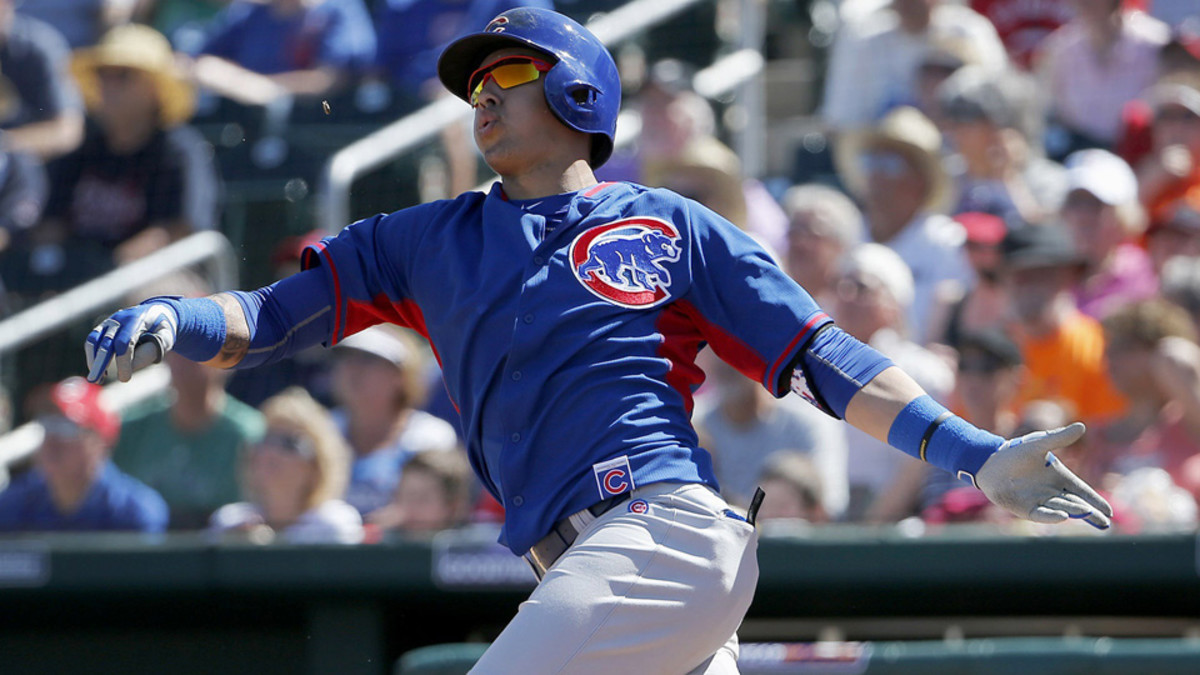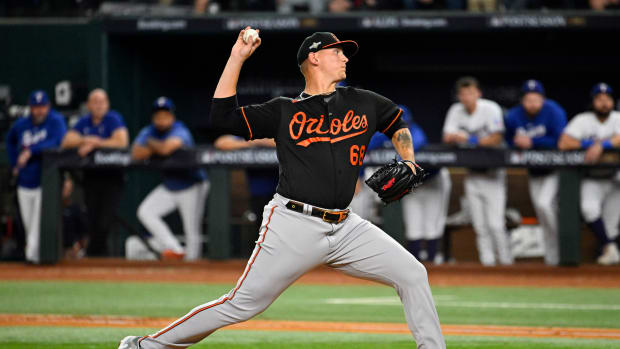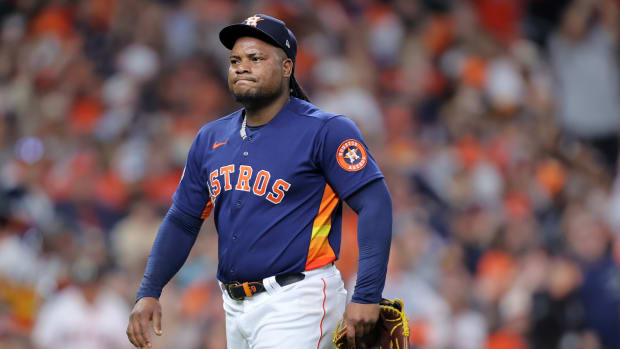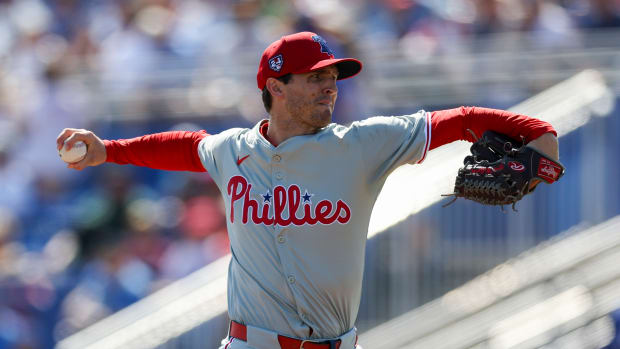
Preaching patience for talented Cubs trio of Soler, Baez and Bryant
In case you missed it, a scene out of Cubs fan fiction played out in real life in Chicago's 10-6 loss to Cleveland on Tuesday afternoon, when top prospects Jorge Soler, Javier Baez and Kris Bryant hit consecutive home runs to lead off the fourth inning against Indians starter Trevor Bauer. As far as spring training prospect porn goes, it doesn't get much better than this:
Cubs fans can be excused for watching that sequence on a loop and fantasizing about how many runs are coming this year with those three joining Anthony Rizzo and Starlin Castro in a lineup that plays 81 of its games at Wrigley Field. But as a public service, I want to offer the following dose of reality.
Castillo, Tomas lead group of must-watch Cuban rookies in 2015
Let's take the three in the order in which they hit on Tuesday. Soler is a 23-year-old Cuban rightfielder with a rocket for an arm and the build of a running back who signed a nine-year, $30 million contract with the Cubs just four months after his twentieth birthday. He's earned numerous comparisons to his countrymen Yasiel Puig and Yoenis Cespedes, as well as the expectation that Soler will have the same immediate impact on the league that those two had. That Soler hit .292/.330/.573 in 97 plate appearances in his major league debut last season only seemed to confirm those expectations.
That line is misleading, however. Soler went 10-for-19 with seven extra-base hits and three homers in his first five major league games, but in the final 19 games of his debut, all of them starts, he hit .229/.273/.400 and struck out in 26 percent of his plate appearances. Soler hit .331/.422/.709 between Double A and Triple A last year, but that was in just 206 PA. He hit .288/.353/.465 (still good but far more human) in 385 PA in his previous two minor league seasons.
• JAFFE: Loss of Stroman is brutal blow to Jays' contender hopes
Perhaps most significantly, even with his 2013 stint in the Arizona Fall League included (he hit .271/.311/.376 in that hitter-friendly league, by the way), Soler hasn't played in more than 75 games in a single season in his entire life. His last two seasons have been cut short by leg injuries: a stress fracture in his shin in '13 and a strained hamstring that cost him more than two months of last year. Given all of that, Soler comes with a list of ifs. If he can adjust to major league pitching, which clearly adjusted to him rather quickly last year, and if he can stay healthy, he still has to develop the stamina to endure a 162-game season. I fully expect Soler to show flashes of his All-Star potential as the Cubs' starting rightfielder this season, but a second-half swoon seems likely, as does considerable streakiness.
As NL hoards top starters, game must change—but not by adding DH
Baez—the only member of this trio to lose his rookie status last year—has made a name for himself as an all-or-nothing hitter prone to both homers and strikeouts. In 229 major league PA last year, he struck out 95 times; that 41.5 percent strikeout rate is the highest in MLB history for a player with 200 or more plate appearances. He still managed to hit nine home runs in that span, putting him on pace for 28 homers over 162 games, but did so with a dismal .169/.227/.324 batting line. That likely did more to temper expectations for the 22-year-old Puerto Rican infielder that I could possibly do here, and the fact that his home run on Tuesday currently stands as his only time on base in 11 spring PA would seem to only support concerns about his viability as a major league hitter.
Rather than temper, however, I'll shine a ray of hope on Baez. He has a history of dismal struggles upon reaching a new league, as well as a history of overcoming those early struggles. For example, in his first exposure to High A at the end of 2012, Baez hit .188/.244/.400 in 86 PA. The next year, he repeated the level and hit .274/.338/.535. Last year, he hit .145/.230/.255 through his first 122 PA in Triple A, then hit .306/.359/.612 over his next 312 to force his way up to the majors. That Triple A performance is particularly informative—he struck out in 37 percent of those first 122 PA, but still managed to adjust to the level. In his final 312 PA at Triple A, meanwhile, he struck out in "just" 27 percent of his PA.
Baez's strikeouts are always going to come in bunches, but strikeouts alone will not doom a hitter. Last year, two of the league's best hitters combined to strike out 354 times, with AL MVP Mike Trout leading the American League with 184 whiffs and NL MVP runner-up Giancarlo Stanton striking out 170 times despite his season being cut short. As Tom Verducci wrote last week, Baez has brought a new two-strike approach to camp this spring, and new manager Joe Maddon has been working with him on his swing (and with the Cubs' hitters in general on making more consistent contact).
• JAFFE: Cuban free agent Olivera a mysterious combo of risk, upside
Has the time come for the National League to adopt the DH?
There's plenty of room for cynicism regarding Baez's major league potential, and it's likely that he'll take longer to adjust to MLB than to High A and Triple A. But this is a player who hit .278/.336/.548 over his last three minor league seasons—his age-19 to -21 seasons, no less—and went deep at a 40-homer pace over 162 games. He may not replicate those numbers this season, but if the Cubs give him the opportunity to make the necessary adjustments, he very well could in 2016.
As for Bryant, with no major league exposure to temper expectations for the 23-year-old third baseman and No. 2 pick in the 2013 draft, we only have his unassailable .327/.428/.666 minor league line and 52 home runs in his first 174 professional games with which to work. Temperance here comes from the fact that the jump from Triple A to the majors has proven an increasingly difficult one for hitters in recent seasons. Even Trout hit just .220/.281/.390 in his first major league exposure, 135 already-forgotten PA in '11.
Also, unlike Baez and Soler, who finished 2014 as regulars in the Cubs' lineup, Bryant is likely to start '15 back in Triple A because of service time concerns. I doubt the Cubs will be able to hold out until mid-June to protect against Bryant's potential Super-Two arbitration status, but they're very likely to wait until at least mid-April to delay his free agency a year, as the Astros did last year with George Springer.
Kris Bryant leads list of impact rookie hitters to watch in 2015
Still, expectations for Bryant, the early favorite for NL Rookie of the Year honors, will continue to exceed those for Soler and Baez, and there's little reason to believe they shouldn't. Beyond the fact that Bryant's opposite-field home run was arguably the most impressive of Tuesday's troika, there's the matter of the players' respective PECOTA projections from Baseball Prospectus. That system pegs Baez for a still-troubling .225/.270/.427, and Soler for a more earth-bound .258/.316/.457; the latter has a worrisome trio of top comparables in Wil Myers, Wladimir Balentien and Domonic Brown. Bryant, however, draws a .261/.351/.514 projection from PECOTA, and his top comparable is none other than Stanton. But, hey, no pressure.
Ultimately, all three of these Cubs sluggers are huge talents, and I'm super excited, too. But it's important to remember that, despite their expected presence in the major league lineup this year, 2015 will be yet another development year for all three. As for '16, however, look out, and don't say I didn't tell you so.


































